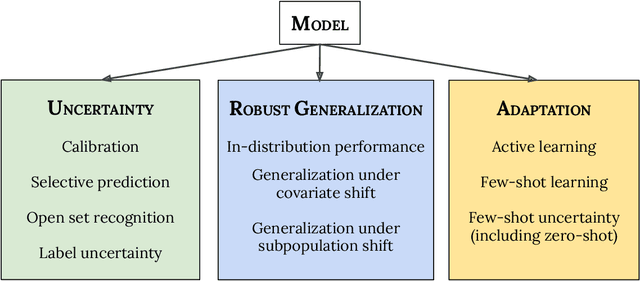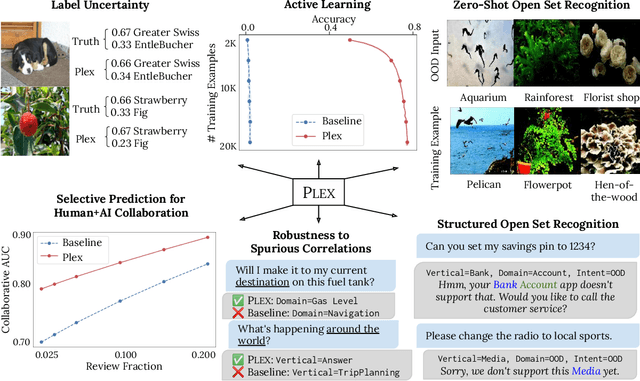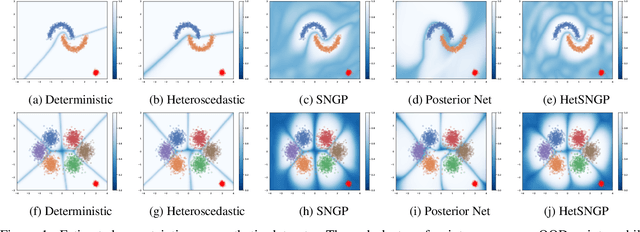Jeremiah Liu
Robust Disaster Assessment from Aerial Imagery Using Text-to-Image Synthetic Data
May 22, 2024Abstract:We present a simple and efficient method to leverage emerging text-to-image generative models in creating large-scale synthetic supervision for the task of damage assessment from aerial images. While significant recent advances have resulted in improved techniques for damage assessment using aerial or satellite imagery, they still suffer from poor robustness to domains where manual labeled data is unavailable, directly impacting post-disaster humanitarian assistance in such under-resourced geographies. Our contribution towards improving domain robustness in this scenario is two-fold. Firstly, we leverage the text-guided mask-based image editing capabilities of generative models and build an efficient and easily scalable pipeline to generate thousands of post-disaster images from low-resource domains. Secondly, we propose a simple two-stage training approach to train robust models while using manual supervision from different source domains along with the generated synthetic target domain data. We validate the strength of our proposed framework under cross-geography domain transfer setting from xBD and SKAI images in both single-source and multi-source settings, achieving significant improvements over a source-only baseline in each case.
Using Domain Knowledge to Guide Dialog Structure Induction via Neural Probabilistic Soft Logic
Mar 26, 2024



Abstract:Dialog Structure Induction (DSI) is the task of inferring the latent dialog structure (i.e., a set of dialog states and their temporal transitions) of a given goal-oriented dialog. It is a critical component for modern dialog system design and discourse analysis. Existing DSI approaches are often purely data-driven, deploy models that infer latent states without access to domain knowledge, underperform when the training corpus is limited/noisy, or have difficulty when test dialogs exhibit distributional shifts from the training domain. This work explores a neural-symbolic approach as a potential solution to these problems. We introduce Neural Probabilistic Soft Logic Dialogue Structure Induction (NEUPSL DSI), a principled approach that injects symbolic knowledge into the latent space of a generative neural model. We conduct a thorough empirical investigation on the effect of NEUPSL DSI learning on hidden representation quality, few-shot learning, and out-of-domain generalization performance. Over three dialog structure induction datasets and across unsupervised and semi-supervised settings for standard and cross-domain generalization, the injection of symbolic knowledge using NEUPSL DSI provides a consistent boost in performance over the canonical baselines.
Gemini 1.5: Unlocking multimodal understanding across millions of tokens of context
Mar 08, 2024Abstract:In this report, we present the latest model of the Gemini family, Gemini 1.5 Pro, a highly compute-efficient multimodal mixture-of-experts model capable of recalling and reasoning over fine-grained information from millions of tokens of context, including multiple long documents and hours of video and audio. Gemini 1.5 Pro achieves near-perfect recall on long-context retrieval tasks across modalities, improves the state-of-the-art in long-document QA, long-video QA and long-context ASR, and matches or surpasses Gemini 1.0 Ultra's state-of-the-art performance across a broad set of benchmarks. Studying the limits of Gemini 1.5 Pro's long-context ability, we find continued improvement in next-token prediction and near-perfect retrieval (>99%) up to at least 10M tokens, a generational leap over existing models such as Claude 2.1 (200k) and GPT-4 Turbo (128k). Finally, we highlight surprising new capabilities of large language models at the frontier; when given a grammar manual for Kalamang, a language with fewer than 200 speakers worldwide, the model learns to translate English to Kalamang at a similar level to a person who learned from the same content.
Gemini: A Family of Highly Capable Multimodal Models
Dec 19, 2023Abstract:This report introduces a new family of multimodal models, Gemini, that exhibit remarkable capabilities across image, audio, video, and text understanding. The Gemini family consists of Ultra, Pro, and Nano sizes, suitable for applications ranging from complex reasoning tasks to on-device memory-constrained use-cases. Evaluation on a broad range of benchmarks shows that our most-capable Gemini Ultra model advances the state of the art in 30 of 32 of these benchmarks - notably being the first model to achieve human-expert performance on the well-studied exam benchmark MMLU, and improving the state of the art in every one of the 20 multimodal benchmarks we examined. We believe that the new capabilities of Gemini models in cross-modal reasoning and language understanding will enable a wide variety of use cases and we discuss our approach toward deploying them responsibly to users.
On Uncertainty Calibration and Selective Generation in Probabilistic Neural Summarization: A Benchmark Study
Apr 17, 2023



Abstract:Modern deep models for summarization attains impressive benchmark performance, but they are prone to generating miscalibrated predictive uncertainty. This means that they assign high confidence to low-quality predictions, leading to compromised reliability and trustworthiness in real-world applications. Probabilistic deep learning methods are common solutions to the miscalibration problem. However, their relative effectiveness in complex autoregressive summarization tasks are not well-understood. In this work, we thoroughly investigate different state-of-the-art probabilistic methods' effectiveness in improving the uncertainty quality of the neural summarization models, across three large-scale benchmarks with varying difficulty. We show that the probabilistic methods consistently improve the model's generation and uncertainty quality, leading to improved selective generation performance (i.e., abstaining from low-quality summaries) in practice. We also reveal notable failure patterns of probabilistic methods widely-adopted in NLP community (e.g., Deep Ensemble and Monte Carlo Dropout), cautioning the importance of choosing appropriate method for the data setting.
Neural-Symbolic Inference for Robust Autoregressive Graph Parsing via Compositional Uncertainty Quantification
Jan 26, 2023Abstract:Pre-trained seq2seq models excel at graph semantic parsing with rich annotated data, but generalize worse to out-of-distribution (OOD) and long-tail examples. In comparison, symbolic parsers under-perform on population-level metrics, but exhibit unique strength in OOD and tail generalization. In this work, we study compositionality-aware approach to neural-symbolic inference informed by model confidence, performing fine-grained neural-symbolic reasoning at subgraph level (i.e., nodes and edges) and precisely targeting subgraph components with high uncertainty in the neural parser. As a result, the method combines the distinct strength of the neural and symbolic approaches in capturing different aspects of the graph prediction, leading to well-rounded generalization performance both across domains and in the tail. We empirically investigate the approach in the English Resource Grammar (ERG) parsing problem on a diverse suite of standard in-domain and seven OOD corpora. Our approach leads to 35.26% and 35.60% error reduction in aggregated Smatch score over neural and symbolic approaches respectively, and 14% absolute accuracy gain in key tail linguistic categories over the neural model, outperforming prior state-of-art methods that do not account for compositionality or uncertainty.
Plex: Towards Reliability using Pretrained Large Model Extensions
Jul 15, 2022



Abstract:A recent trend in artificial intelligence is the use of pretrained models for language and vision tasks, which have achieved extraordinary performance but also puzzling failures. Probing these models' abilities in diverse ways is therefore critical to the field. In this paper, we explore the reliability of models, where we define a reliable model as one that not only achieves strong predictive performance but also performs well consistently over many decision-making tasks involving uncertainty (e.g., selective prediction, open set recognition), robust generalization (e.g., accuracy and proper scoring rules such as log-likelihood on in- and out-of-distribution datasets), and adaptation (e.g., active learning, few-shot uncertainty). We devise 10 types of tasks over 40 datasets in order to evaluate different aspects of reliability on both vision and language domains. To improve reliability, we developed ViT-Plex and T5-Plex, pretrained large model extensions for vision and language modalities, respectively. Plex greatly improves the state-of-the-art across reliability tasks, and simplifies the traditional protocol as it improves the out-of-the-box performance and does not require designing scores or tuning the model for each task. We demonstrate scaling effects over model sizes up to 1B parameters and pretraining dataset sizes up to 4B examples. We also demonstrate Plex's capabilities on challenging tasks including zero-shot open set recognition, active learning, and uncertainty in conversational language understanding.
Reliable Graph Neural Networks for Drug Discovery Under Distributional Shift
Nov 25, 2021

Abstract:The concern of overconfident mis-predictions under distributional shift demands extensive reliability research on Graph Neural Networks used in critical tasks in drug discovery. Here we first introduce CardioTox, a real-world benchmark on drug cardio-toxicity to facilitate such efforts. Our exploratory study shows overconfident mis-predictions are often distant from training data. That leads us to develop distance-aware GNNs: GNN-SNGP. Through evaluation on CardioTox and three established benchmarks, we demonstrate GNN-SNGP's effectiveness in increasing distance-awareness, reducing overconfident mis-predictions and making better calibrated predictions without sacrificing accuracy performance. Our ablation study further reveals the representation learned by GNN-SNGP improves distance-preservation over its base architecture and is one major factor for improvements.
Deep Classifiers with Label Noise Modeling and Distance Awareness
Oct 06, 2021



Abstract:Uncertainty estimation in deep learning has recently emerged as a crucial area of interest to advance reliability and robustness in safety-critical applications. While there have been many proposed methods that either focus on distance-aware model uncertainties for out-of-distribution detection or on input-dependent label uncertainties for in-distribution calibration, both of these types of uncertainty are often necessary. In this work, we propose the HetSNGP method for jointly modeling the model and data uncertainty. We show that our proposed model affords a favorable combination between these two complementary types of uncertainty and thus outperforms the baseline methods on some challenging out-of-distribution datasets, including CIFAR-100C, Imagenet-C, and Imagenet-A. Moreover, we propose HetSNGP Ensemble, an ensembled version of our method which adds an additional type of uncertainty and also outperforms other ensemble baselines.
Measuring and Improving Model-Moderator Collaboration using Uncertainty Estimation
Jul 09, 2021



Abstract:Content moderation is often performed by a collaboration between humans and machine learning models. However, it is not well understood how to design the collaborative process so as to maximize the combined moderator-model system performance. This work presents a rigorous study of this problem, focusing on an approach that incorporates model uncertainty into the collaborative process. First, we introduce principled metrics to describe the performance of the collaborative system under capacity constraints on the human moderator, quantifying how efficiently the combined system utilizes human decisions. Using these metrics, we conduct a large benchmark study evaluating the performance of state-of-the-art uncertainty models under different collaborative review strategies. We find that an uncertainty-based strategy consistently outperforms the widely used strategy based on toxicity scores, and moreover that the choice of review strategy drastically changes the overall system performance. Our results demonstrate the importance of rigorous metrics for understanding and developing effective moderator-model systems for content moderation, as well as the utility of uncertainty estimation in this domain.
 Add to Chrome
Add to Chrome Add to Firefox
Add to Firefox Add to Edge
Add to Edge